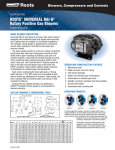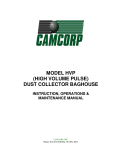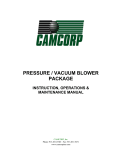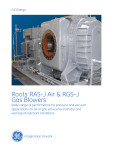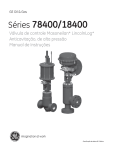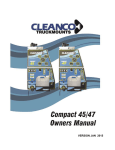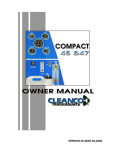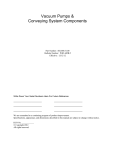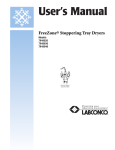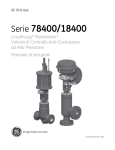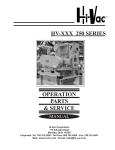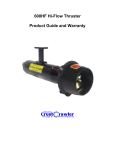Download GE Severe Service Valves masoneilan lincolnlog valve Technical Specifications
Transcript
GE Oil & Gas 78400/18400 Series Masoneilan* LincolnLog* High Pressure Anti-Cavitation Control Valves Contents Features��������������������������������������������������������������������������������������������������3 Valve Sizing Guidelines��������������������������������������������������������������������9 General Data����������������������������������������������������������������������������������������4 Staging Ratios and Pressure Drop Guidelines����������������������9 Numbering System����������������������������������������������������������������������������5 Materials of Construction������������������������������������������������������������10 Temperature Range / Seat Leakage�����������������������������������������5 Soft Seat Design�������������������������������������������������������������������������������21 Balance Seal Pressure and Temperature Limits������������������6 Dimensions�����������������������������������������������������������������������������������������22 Ratings / Connections����������������������������������������������������������������������7 Weights������������������������������������������������������������������������������������������������28 Flow Capacity and FL�����������������������������������������������������������������������7 Accessories and Options�������������������������������������������������������������33 Flow Characteristics��������������������������������������������������������������������������8 Sales Offices�������������������������������������������������������������������� Back Cover Trim Seat Protection�������������������������������������������������������������������������8 Features The Masoneilan LincolnLog is the premier high-pressure liquid letdown valve in the process control industry. It is a field proven severe service solution for cavitating and erosive applications in various industries. The LincolnLog is uniquely designed to operate reliably in harsh environments and dirty liquids. Key design features of the LincolnLog include: Cavitation Elimination The multi-step flow path created by the LincolnLog trim design, reduces the pressure drop in multiple stages without allowing the local pressure to drop below the fluid vapor pressure thus preventing cavitation. These active stages throttle in unison to avoid taking the full pressure drop across any individual stage. Dirt Tolerant Wide flow paths in the LincolnLog allow free passage of large particles through the unique trim and body design without causing any damage or loss of capacity. This ensures continuous and efficient operation by eliminating concerns of potential clogging due to entrained particles. The LincolnLog is a proven problem solver in dirty service applications. Heavy Plug Guiding Guiding is provided along the full length of the plug by a hardened liner, which minimizes any vibration effects and results in excellent dynamic stability. This helps to improve product yield through accurate and smooth process control. Versatile Trim Options Standard LincolnLog trim is available in 3, 4 and 6 stages with different staging ratios to cover the vast majority of high-pressure liquid letdown services. 2 Masoneilan can also provide engineered solutions consisting of additional stages to satisfy specific application requirements. The LincolnLog is available with both balanced and unbalanced plug designs for greater application flexibility. Protected Seat Design Overlap is designed into the trim at low lift to keep high velocity flow away from the valve seat. This helps to avoid seat erosion and extends the operating life under high pressure drop conditions. Reliable Tight Shutoff Standard seat leakage rating for the LincolnLog meets IEC 534-4 and ANSI/FCI 70.2 Class V shutoff. An optional soft seat design provides Class VI bubble tight shutoff. It includes a patented sliding metal collar design, which protects the soft seat from extruding and serves as a back-up seating surface. The LincolnLog can also be supplied with block valve tight shutoff per MSS-SP-61. Ease of Maintenance LincolnLog’s simple top-entry design includes quick change trim for easy access and removal. The integral liner and seat ring also reduces the number of components and simplifies assembly and disassembly. NACE and PED Compliance The LincolnLog is available for Sour Service Applications using the design and construction methods defined in NACE Standard MR0103. Product configurations for applications requiring compliance to MR0175 - 2003 or ISO 15156 are also available upon request. The LincolnLog is also designed for compliance with Pressure Equipment Directives (PED) requirements. General Data Flow Direction Standard:Flow-to-open ■■ Body Type: cast or forged globe style cast or forged angle style Sizes: 1” to 8” (DN 25 to DN 200) Ratings:ANSI Class 600 to 2500 (ISO PN 100 to 420) API 5000 to 10000 End connections:RFF, RTJ, socket weld, butt weld, threaded print flanges (forgings) ■■ Bonnet Type:Bolted Standard Extension ■■ Body and Bonnet Materials: carbon steel 316 stainless steel chrome-moly others ■■ Trim Plug type: multi-step axial flow (3, 4 and 6 stages) Seat type: quick change integral with plug liner (1” & 1.5” sizes) metal seat soft seat Guide: heavy top guided (liner) CV ratio:see Flow Capacity tables (page 7) Flow characteristics:Modified linear (see page 8) ■■ Actuator Type:Spring-diaphragm Spring-return cylinder Double-acting cylinder Handwheel:Optional ■■ Optional designs are also available, such as larger sizes, higher pressure ratings, special materials, or additional trim stages as required. Consult factory for design details and specifications. 3 Numbering System 1st 2nd 1st Body Series Actuator Type 1Globe 20 Top Mounted Manual Handwheel 7Angle 87 Spring-Diaphragm 2nd 3rd 8 4 Trim Type 4 Axial Flow High Resistance (Downseating) 4th No. of Stages* 3Three 4Four 6Six Air to Close 5th 6th Optional Configuration Trim Size 0 Optional Trim FForged 1 Trim A, Balanced Hard Seat Body Design EBExtension 2 Trim B, Balanced Hard Seat 88Spring-Diaphragm Air to Open Bonnet 3 Trim C, Balanced Hard Seat 84 Cylinder: Spring Return, Direct, Air to Close, Single or Double Acting (Fail Open Action 4 Trim A, Balanced Soft Seat 5 Trim B, Balanced Soft Seat 85 Cylinder: Spring Return, Reverse Air to Open, Single or Double Acting (Fail to Close) 6 Trim C, Balanced Soft Seat 7 Trim A, Unbalanced Hard Seat 86 Cylinder: Double Acting, Without Springs, Air to Open or Air to Close Action 8 Trim B, Unbalanced Hard Seat *Additional stages are available to meet specific operating conditions. Please consult Masoneilan. 9 Trim C, Unbalanced Hard Seat Temperature Range / Seat Leakage Valve Sizes Temperature Range (1) inches DN 1 25 1.5 to 8 40 to 200 2 to 8 50 to 200 Trim Type Seat Type Unbalanced min. max.(4) Metal Seat -20°F (-29°C) 600°F (316°C) Balanced Metal Seat -20°F (-29°C) 600°F (316°C) Unbalanced Metal Seat -20°F (-29°C) 600°F (316°C) Balanced or Unbalanced Soft Seat -20°F (-29°C) 450°F (232°C) Seat Leakage Class (2) V (See Note 3) VI 1. Designs for higher or lower temperatures are available. Please consult Masoneilan. 2. Seat leakage class ratings per IEC 534-4 and ANSI/FCI 70.2. Class V seat leakage is standard and Class VI is optional. 3. Optional block valve tight shutoff per MSS-SP-61 also available. 4. Max. temp. limit of 600°F (316°C) with unbalanced trim requires use of optional flexible graphite packing or an extension bonnet. 4 Balance Seal Pressure and Temperature Limits LincolnLog 78400/18400 Balance Seal Pressure-Temperature Application Range 7000 (483) 6000 (414) 5000 (345) Pressure in psi (bar) 4000 (276) PTFE (Fluoroloy® A21) with Elgiloy® Spring and PTFE Back-up Rings 3000 (207) 2000 (138) 1000 (69) 0 200°F (93°C) 300°F (149°C) 400°F (204°C) 500°F (260°C) 600°F (316°C) 700°F (371°C) Temperature Range in °F (°C) Ratings/Connections q RF Flanged l Socket Weld Valve Size m Threaded Δ RT Joint n Butt Weld Pressure Class (2) (1) inches DN 600 900 1500 2500 1 & 1.5 25 & 40 qlmΔn qlmΔn qlmΔn qlmΔn 2 50 qlmΔn qlmΔn qlmΔn qlmΔn 3 80 qΔn qΔn qΔn qΔn 4 100 qΔn qΔn qΔn qΔn 6 150 qΔn qΔn qΔn qΔn 8 200 qΔn qΔn qΔn qΔn 1) Sizes, ratings and end connections are available in both globe and angle body styles. 2) Pressure classes shown represent ASME/ANSI ratings and equivalent PN ratings. 5 Flow Capacity and FL Satandard Capacity — 3-Stage Design Valve Size Inches Flow Characteristic: MODIFIED LINEAR Orifice Diameter DN Inches Travel mm Inches mm CV Min, Cont. CV FL 1 25 .70 17.8 .25 6.35 2.0 .98 .05 1.5 40 1.00 25.4 .25 6.35 3.8 .98 .10 2 50 1.50 38.1 .38 9.65 9.0 .98 .15 3 80 2.25 57.2 .62 15.7 20 .98 .25 4 100 2.88 73.2 .75 19.1 34 .98 .43 6 150 4.12 105 1.00 25.4 65 .98 .56 8 200 5.38 137 1.25 31.8 135 .98 1.0 Satandard Capacity — 4-Stage Design Valve Size Flow Characteristic: MODIFIED LINEAR Orifice Diameter Travel Trim A Trim B Trim C Min, Cont. CV Inches DN Inches mm Inches mm CV FL CV FL CV FL 1 25 .70 17.8 .25 6.35 1.0 .996 1.4 .994 1.7 .991 .04 1.5 40 1.00 25.4 .25 6.35 1.9 .996 2.5 .994 3.2 .991 .08 2 50 1.50 38.1 .38 9.65 4.5 .996 6.0 .994 7.5 .991 .12 3 80 2.25 57.2 .62 15.7 10 .996 13 .994 16.5 .991 .20 4 100 2.88 73.2 .75 19.1 16.5 .996 22 .994 28 .991 .35 6 150 4.12 105 1.00 25.4 34 .996 45 .449 56 .991 .46 8 200 5.38 137 1.25 31.8 70 .996 90 .994 115 .991 .80 Satandard Capacity — 6-Stage Design Valve Size 6 Trim C Flow Characteristic: MODIFIED LINEAR Orifice Diameter Travel Trim A Trim B Trim C Inches DN Inches mm Inches mm CV FL CV FL CV FL 1 25 .70 17.8 .25 6.35 .80 .996 1.0 .994 1.4 .991 Min, Cont. CV .03 1.5 40 1.00 25.4 .25 6.35 1.4 .996 1.8 .994 2.5 .991 .05 2 50 1.50 38.1 .38 9.65 3.5 .996 4.5 .994 6.0 .991 .08 3 80 2.25 57.2 .62 15.7 7.5 .996 9.5 .994 13 .991 .13 4 100 2.88 73.2 .75 19.1 12 .996 16 .994 22 .991 .22 6 150 4.12 105 1.00 25.4 25 .996 33 .449 45 .991 .30 8 200 5.38 137 1.25 31.8 50 .996 65 .994 91 .991 .65 Flow Characteristics The LincolnLog trim provides a smooth modified linear control characteristic with “clearance flow” capacity over the initial 15% of valve travel as shown in the generic chart and table at right. LincolnLog CV vs. Travel Incorporation of the multi-stage “clearance flow” design concept prevents high pressure drops across the LincolnLog seating area while throttling at low lifts. This feature helps to extend trim life significantly, resulting in dependable and tight shutoff whenever required. It also improves the throttling control stability and performance at low lifts, while providing smooth, accurate and continuous capacity control from 15% to 100% plug travel. Controllability extends from the Maximum Rated CV to the Minimum Controllable CV for any valve size resulting in typical turndown ratios of 50:1. % Max. Opening 5 10 20 30 40 50 60 70 80 90 100 % Max. CV * * 3 15 27 39 52 64 76 88 100 * Clearance Flow Only Trim Seat Protection The “clearance flow” feature described in the previous section is achieved through the trim overlap design illustrated below: LincolnLog Trim Overlap Seat Protection Feature Flow Direction 0 - 15% of Plug Travel Trim overlap with the valve in the closed or low lift positions. Flow Direction 15 - 100% of Plug Travel There is much greater flow area through the valve seat versus the plug notches. As a result, pressure drop and velocities across the critical seating surfaces are controlled eliminating seat damage. 7 Valve Sizing Guidelines General Trim Selection LincolnLog multi-stage control valves can be sized using either standard IEC/ISA equations or using the latest Masoneilan sizing and selection software program. As indicated in the table below, the LincolnLog is available in various standard trim types and number of stages. Each trim style provides different staging ratios and different pressure drop percentages per stage. Recommended limits for ∆P per stage are 800 psi (60 bar) for continuous duty cycle applications and up to 1000 psi (70 bar) ∆P per stage for intermittent service. The recommended operating throttling ∆P limits are also shown in the table below. Noise Predictions Valve noise calculations can be performed using the Masoneilan sizing and selection program based on the latest IEC equations. The serial stage construction of the LincolnLog design helps to significantly reduce trim noise. Calculating the noise at the last stage of the LincolnLog trim will closely approximate the overall valve noise produced. Pressure drop across the last stage can be derived from the table below and used in the noise calculations. Engineered Solutions For flashing service, the expansion ratio of the fluid will determine the appropriate staging ratio to apply. Non-standard staging ratios can be supplied for compressible two-phase flow or flashing conditions not covered by the standard trim. Please consult Masoneilan for proper sizing and design of engineered solutions for these types of applications. Staging Ratios & Pressure Drop Guidelines No. of Stages Staging Ratios (1x2) C 3 1-1-2 C 4 1-1-1-2 Trim Type B A C B A 4 4 6 6 6 1-1-2-3 1-1-2-4 1-1-1-1-1-2 1-1-1-1-2-3 1-1-1-1-2-4 Pressure Drop per Stage(3) Stages Fraction of Total ΔP 1 to 2 .44 3 .11 1 to 3 .31 4 .08 1 to 2 .42 3 .11 4 .05 1 to 2 .43 3 .11 4 .03 1 to 5 .19 6 .05 1 to 4 .23 5 .06 6 .025 1 to 4 .23 5 .06 6 .014 Maximum Recommended Throttling ΔP Continuous Service Intermittent Service psi bar psi bar 1595 110 2030 140 2248 155 2900 200 1885 130 2320 160 1885 130 2320 160 3698 255 4713 325 3480 240 4350 300 3408 235 4278 295 (1) Staging ratios provide approximations of the relative area ratios for each specific trim type. As an example, a staging ratio of 1-1-2 indicates that the final stage for that trim type has approximately twice the area of the first two stages. (2) Staging ratios do not have any relative correlation between the different trim types. (3) R ecommended limits for ΔP per stage are 800 psi (60 bar) for continuous duty cycle applications and up to 1000 psi (70 bar) ΔP per stage for intermittent service. 8 9 Table 4 - TRI-NADO TM Parts List Item Number 10 Quantity Used Identification 1 2 Headplate 2 1 Cylinder 3 1 Gearbox 5 1 End Cover 7 2 Impeller 8 4 Bearing Clamp Plate 9 2 Gear 12 1 Shaft - Gear End Driven 14 2 Shaft - Opposite Gear End 16 1 Key (coupling) 17 2 Shim Set 18 2 Gasket - Gearbox/End Cover 21 16 Lock Washer (clamp plates) 22 16 Cap Screw - Hex Head (clamp plates) 23 1 Seal - Drive Shaft 27 4 Seal - Inboard 29 2 Lifting Lug 30 76 Cap Screw - Hex Head (covers/plates) 30A 6 Cap Screw - Hex Head (lifting lugs) 31 4 Bearing - Spherical Roller 34 1 Name 35 18 Drive Screw - Round Head (nameplates/arrow) 36 4 Dowel Pin (gearbox alignment) 37 2 Vent Plug 42 54 Cap Screw - Socket Head (impeller) 43 6 Taper Pin (impeller) 44 1 Label - WHISPAIR™ 69 6 Pipe Plug (headplate) 70 5 Pipe Plug gearbox/end cover/cylinder) 74 1 Rotation Arrow 87 2 Sight Plug - Oil Level 92 2 Label - Identification 100 4 Dowel Pin - Pull Out (headplate alignment) 101 2 Lock Nut (gears/bearings) 105 1 Shaft - Gear End Drive Piston Ring Seal 109 4 141 1 Slinger - Opposite Gear End 181 1 Cover Plate - Cylinder 182 12 Cap Screw - Hex Head (cover plate) 184 1 Slinger - Gear End 185 3 Cap Screw - Button Head (slinger) Washer (slinger) 186 6 188 2 Washer - Wavy Spring 194 4 Anti-rotation Pin 194A 4 Washer 196 4 Cap Screw - Hex Head (slinger) 197 2 Close Nipple (vent plug) 198 2 Pipe Coupling (vent plug) 203 4 Flat Washer (slinger) Trouble Shooting Checklist Trouble No flow Low Capacity Excessive Power Overheating of bearings or gears Vibration Item Excessive breather blowby or excessive oil leakage to vent area Remedy Speed too low Check by tachometer and compare with speed on Roots Order Acknowledgement. 2 3 Wrong rotation Obstruction in piping Compare actual rotation, change driver rotation if wrong. Check piping valve, silencer, to assure open flow path. 4 5 Speed too slow Excessive pressure rise 6 7 Obstruction in piping Excessive slip See Item 1. Check inlet vacuum and discharge pressure and compare these figures with specified operation conditions on order. 8 9 10 Speed too high Excessive pressure rise Impeller rubbing See Item 1. See Item 5. Inspect outside of cylinder for high temperature areas, then check for impeller contact at these points. Look for excessive scale build-up. Correct blower mounting drive alignment. 11 12 Inadequate lubrication Excessive lubrication Check oil sump levels in end covers. Check oil levels. If correct, drain and refill with clean oil or recommended grade 13 14 Excessive pressure rise Coupling misalignment See Item 5. Check carefully. Realign if questionable. 15 16 17 Misalignment Impellers rubbing Worn bearings/gears See Item 14. See Item 10. Check gear backlash and condition of bearings and replace as indicated. 18 Unbalanced or rubbing impellers Scale or process material may build up on casing and impellers or inside impellers. Remove build-up to restore original clearances and impeller balance. 19 20 Driver stops or will not start Possible Cause 1 Driver or blower loose Piping resonance See Item 3. Check inside of casing for worn or eroded surfaces causing excessive clearances. Tighten mounting bolts accurately. Determine whether standing wave pressure pulsations are present in the piping. Refer to Sales Office. 21 Impeller stuck Check for excessive hot spot on headplate or cylinder. See Item 10. Look for detective shaft, bearing and/or gear teeth. 22 Broken seal Replace seals 11 GE Oil & Gas Roots Blowers, Compressors and Controls Houston, Texas Headquarters | U.S. Toll Free T 1 877 363 7668 | T +1 832 590 2600 Connersville, Indiana Operations | U.S. Toll Free T 1 877 442 7910 | T +1 765 827 9285 Waukesha, Wisconsin Operations | T +1 262 650 5965 | Email: [email protected] European Operations | T +44 (0) 1695 52600 | Email: [email protected] USA/Canada Sales | T +1 773 444 3360 Houston, Texas Factory Service | T +1 713 896 4810 Mexico City Sales and Factory Service | T +52 55 5889 5811 Dubai Sales and Factory Service | T +971 4 8855481 Malaysia Sales | T +60 3 2267 2600 China Sales | T +86 10 8486 2440 Shanghai Factory Service | T +86 21 5858 7638 Visit us online at: www.geoilandgas.com/valves 2013 General Electric Company All Rights Reserved *Denotes trademarks of General Electric Company GEA19511 ILRB_3007 04/2013












